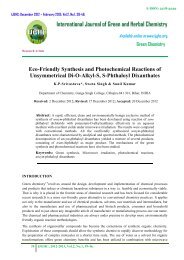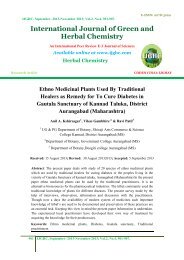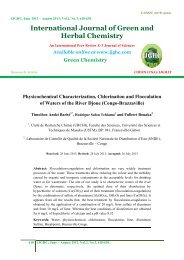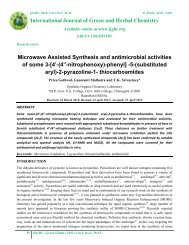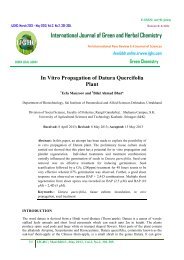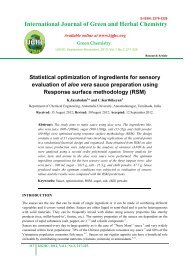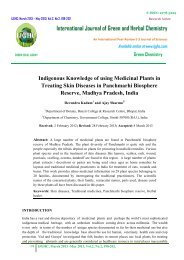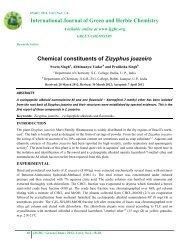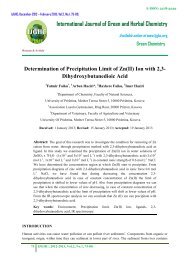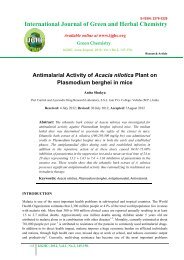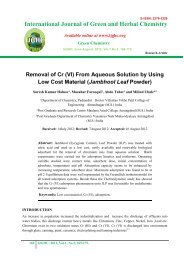Gene Therapy A Solution to Genetic Diseases - IJGHC
Gene Therapy A Solution to Genetic Diseases - IJGHC
Gene Therapy A Solution to Genetic Diseases - IJGHC
Create successful ePaper yourself
Turn your PDF publications into a flip-book with our unique Google optimized e-Paper software.
<strong>IJGHC</strong>, June 2013 – August 2013; Vol.2, No.3; 596-609.<br />
International Journal of Green and<br />
Herbal Chemistry<br />
An International Peer Review E-3 Journal of Sciences<br />
Available online at www.ijghc.com<br />
Green Chemistry<br />
E-ISSN: 2278-3229<br />
Review Article<br />
CODEN (USA): IJGHAY<br />
<strong>Gene</strong> <strong>Therapy</strong> A <strong>Solution</strong> <strong>to</strong> <strong>Gene</strong>tic <strong>Diseases</strong><br />
Ighere D.A,* and Okere A.U<br />
National Centre for <strong>Gene</strong>tic Resources and Biotechnology (NACGRAB),<br />
P.M.B 5382, Moor Plantation, Apata, Ibadan, Nigeria.<br />
Received: 20 May 2013; Revised: 10 July 2013; Accepted: 24 July 2013<br />
Abstract: Over the years, some diseases have come <strong>to</strong> plague the human race<br />
that there appears <strong>to</strong> be no solution in sight. The emergence of gene therapy<br />
techniques has gradually unveiled the mystery behind these diseases and at the<br />
same time provides promising therapeutic measures <strong>to</strong> these disease conditions.<br />
<strong>Gene</strong> <strong>Therapy</strong> has exposed researchers <strong>to</strong> the effective and promising ways <strong>to</strong><br />
tackle diseases that are genetic in nature. This review article articulates the major<br />
landmark achievements of <strong>Gene</strong> <strong>Therapy</strong> over the years while also enunciating the<br />
different approaches that used in delivering therapeutic genes <strong>to</strong> target host cells.<br />
In gene therapy, a therapeutic gene could be delivered <strong>to</strong> the host target cell<br />
through a viral vec<strong>to</strong>r or non-viral vec<strong>to</strong>r. In viral vec<strong>to</strong>r delivery of therapeutic<br />
gene, a modified virus that lacks a pathogenic gene used <strong>to</strong> deliver the therapeutic<br />
gene <strong>to</strong> the host. The technique of gene therapy involves the correction of<br />
defective genes responsible for disease development. Researchers use one of<br />
several approaches for correcting faulty genes: A normal gene may be inserted<br />
in<strong>to</strong> a nonspecific location within the genome <strong>to</strong> replace a nonfunctional gene.<br />
This approach is most common. An abnormal gene could be swapped for a normal<br />
gene through homologous recombination. The abnormal gene could be repaired<br />
through selective reverse mutation, which returns the gene <strong>to</strong> its normal function.<br />
The regulation (the degree <strong>to</strong> which a gene is turned on or off) of a particular gene<br />
could be altered. Cancer is one of the major diseases that researchers are trying <strong>to</strong><br />
596 <strong>IJGHC</strong>; June – August 2013, Vol.2, No.3, 596-609.
<strong>Gene</strong>...<br />
Ighere D.A. et al.<br />
use gene therapy <strong>to</strong> cure. Cancer is a disease that occurs because of multiple<br />
mutations in a cell that cause the cell <strong>to</strong> proliferate out of control.<br />
Keywords: <strong>Gene</strong> <strong>Therapy</strong>, Vec<strong>to</strong>r, <strong>Gene</strong>, Virus and Mutation<br />
.<br />
INTRODUCTION<br />
A gene is the basic unit of heredity found in the cells of living organisms, from bacteria <strong>to</strong> humans. It<br />
is the gene in combination with the environment that determines the phenotypic characteristics of an<br />
individual. The genes are specific base sequences that encode instruction on how <strong>to</strong> make proteins. A<br />
disorder may result in a gene such that the gene is altered and the encoded proteins are unable <strong>to</strong> carry<br />
out their normal functions. Basic gene therapy approaches usually involve adding a therapeutic gene<br />
<strong>to</strong> a cell through a variety of vec<strong>to</strong>rs. Most research and testing has been done with the vec<strong>to</strong>r<br />
introduction of a sequence that codes for a needed protein, either <strong>to</strong> counter a deficiency, induce a<br />
strong immune response, or destroy tumour cells 1 .<br />
The concepts of gene therapy arose initially during the 1960s and early 1970s whilst the development<br />
of genetically marked cell lines and the clarification of mechanisms of cell transformation by the<br />
papovaviruses polyoma and SV40 was in progress 2 . With the arrival of recombinant DNA techniques,<br />
cloned genes became available and were used <strong>to</strong> demonstrate that foreign genes could indeed correct<br />
genetic defects and disease phenotypes in mammalian cells in vitro 2 . Efficient retroviral vec<strong>to</strong>rs and<br />
other gene transfer methods have permitted convincing demonstrations of efficient phenotype<br />
correction in vitro and in vivo, now making gene therapy a broadly accepted approach <strong>to</strong> therapy and<br />
justifying clinically applied studies with human patients. <strong>Gene</strong> therapy is the introduction of gene in<strong>to</strong><br />
existing cells <strong>to</strong> prevent or treat a wide range of diseases 3 . <strong>Gene</strong> therapy is thus the medical treatment<br />
that manipulates a gene or genes within cells in order <strong>to</strong> produce proteins that change the function of<br />
those cells. <strong>Gene</strong> therapy originated in efforts <strong>to</strong> treat and cure some of the more than 9,000 known<br />
genetic disorders, most of which lack an effective therapy. Scientists first <strong>to</strong>ok the logical step of<br />
trying <strong>to</strong> introduce genes directly in<strong>to</strong> human cells, focusing on diseases caused by single-gene<br />
defects, such as cystic fibrosis, haemophilia, muscular dystrophy and sickle cell anaemia. However,<br />
this has proven more difficult than modifying bacteria, primarily because of the problems involved in<br />
carrying large sections of DNA and delivering them <strong>to</strong> the correct site on the comparatively large<br />
genome. Today, most gene therapy studies are aimed at cancer and hereditary diseases linked <strong>to</strong> a<br />
genetic defect 4 .<br />
Although gene therapy offers seemingly limitless possibilities, researchers have been thwarted by<br />
many technical problems. Successful clinical trial using gene therapy started in April 2000, when<br />
French researchers reported the successful use of gene therapy <strong>to</strong> treat two female infants with severe<br />
combined immunodeficiency disease (SCID), a deadly inherited disease that impairs the immune<br />
system. However, even this success was marred when each child later developed a rare leukaemia-like<br />
illness, thought <strong>to</strong> be a result of gene therapy. Most clinical trials of gene therapy have not resulted in<br />
enough improvement in the patient’s underlying condition <strong>to</strong> consider it an unqualified success and <strong>to</strong><br />
justify treating large numbers of people. The extraordinary potential of gene therapy has also raised<br />
alarms among critics who warn that the technology could go <strong>to</strong>o far. They note, for example, that<br />
gene therapy could offer wealthy families opportunities for genetic enhancement unavailable <strong>to</strong> the<br />
poor. More troubling still for some critics is that gene therapy is potential <strong>to</strong> narrow the human gene<br />
pool, producing unknown, and possibly harmful, consequences.<br />
The majority of clinical gene therapy trials are being conducted in the United States and Europe, with<br />
only a modest number initiated in other countries, including Australia. The majority of these trials<br />
597 <strong>IJGHC</strong>; June – August 2013, Vol.2, No.3, 596-609.
<strong>Gene</strong>...<br />
Ighere D.A. et al.<br />
focus on treating acquired conditions such as cancer. The only gene therapy that has been approved<br />
for routine treatment so far is for a form of cancer which was approved 5 in China in early 2004.<br />
<strong>Gene</strong> <strong>Therapy</strong> has made important medical advances in less than two decades. Within this short time<br />
span, it has moved from the conceptual stage <strong>to</strong> technology development and labora<strong>to</strong>ry research <strong>to</strong><br />
clinical translational trials for a variety of deadly diseases. This article wish <strong>to</strong> bring <strong>to</strong> the general<br />
public recent development that has happen in gene therapy technology and at the same time state<br />
some potentials that gene therapy technology posses. In time past, some diseases have posed serious<br />
challenges <strong>to</strong> the field of medicine especially genetic diseases, and gradually with the emergence of<br />
gene therapy, those disease will be adequately treated with the technique.<br />
GENE THERAPY AND HOW IT WORKS<br />
<strong>Gene</strong> therapy involves the insertion of a therapeutic gene in<strong>to</strong> a cell <strong>to</strong> replace a nonfunctional gene.<br />
This is done by using a carrier molecule called a vec<strong>to</strong>r in delivering the therapeutic gene <strong>to</strong> the target<br />
cell. The vec<strong>to</strong>r is usually a virus that has been genetically altered <strong>to</strong> carry normal human DNA <strong>to</strong> the<br />
target cell. All viruses attack their hosts and introduce their genetic material in<strong>to</strong> the host cell as part<br />
of their replication cycle, it is this act that researcher <strong>to</strong>ok advantage of by removing the pathogenic<br />
gene of the virus. The pathogenic gene present in the virus is removed and replaced with a therapeutic<br />
gene, this act render the virus harmless before it is inserted in<strong>to</strong> the host target cell. Stem cell can be<br />
manipulated <strong>to</strong> accept therapeutic genes. In gene therapy, only somatic cells are targeted for<br />
treatment. Therefore, any changes <strong>to</strong> the genes of an individual by gene therapy will only influence<br />
the cells of their body and cannot be passed on <strong>to</strong> their children. Changes <strong>to</strong> the somatic cells cannot<br />
be passed on <strong>to</strong> future generations (cannot be inherited). Somatic gene therapy treats the individual<br />
and has no impact on future generations.<br />
The technique of <strong>Gene</strong> therapy corrects defective genes responsible for disease development.<br />
Researchers may use one of several approaches for correcting faulty genes.<br />
• A normal gene may be inserted in<strong>to</strong> a nonspecific location within the genome <strong>to</strong> replace a<br />
non-functional gene. This approach is most common.<br />
• An abnormal gene could be swapped for a normal gene through homologous recombination.<br />
• The abnormal gene could be repaired through selective reverse mutation, which returns the<br />
gene <strong>to</strong> its normal function.<br />
• The regulation (the degree <strong>to</strong> which a gene is turned on or off) of a particular gene could be<br />
altered.<br />
SUCCESS STORIES AND SOME DISEASES THAT HAVE BEEN TREATED WITH<br />
GENE THERAPY<br />
• Fisher Jennifer in an article published in the Scientist, Magazine of Life Sciences reported<br />
that Sickle Cell disease has been successfully treated in mice through gene therapy; these will<br />
open doors for the disease <strong>to</strong> be treated in man through gene therapy.<br />
• Severe Combined Immune Deficiency (ADA-SCID) is also known as the bubble boy disease.<br />
Affected children are born without an effective immune system and will succumb <strong>to</strong><br />
infections outside of the bubble without bone marrow transplantation from matched donors.<br />
Investiga<strong>to</strong>rs in Italy conducted a landmark study representing a first case of gene therapy<br />
“cure,” or at least a long-term correction, for patients with deadly genetic disorder. The<br />
598 <strong>IJGHC</strong>; June – August 2013, Vol.2, No.3, 596-609.
<strong>Gene</strong>...<br />
Ighere D.A. et al.<br />
therapeutic gene called ADA was introduced in<strong>to</strong> the bone marrow cells of such patients in<br />
the labora<strong>to</strong>ry, followed by transplantation of the genetically corrected cells back <strong>to</strong> the same<br />
patients 6 . The immune system was reconstituted in all six treated patients without noticeable<br />
side effects, who now live normal lives with their families without the need for further<br />
treatment.<br />
• Two scientists at the National Institutes of Health (Bethesda, Maryland) used killer T cells <strong>to</strong><br />
successfully treat metastatic melanoma with gene therapy.<br />
• In a study published in the nature medicine, Ott M.G reported that two adult patient were<br />
successfully treated for disease that affect myeloid cells through gene therapy.<br />
• In March 2006, an international group of scientists announced the successful use of gene<br />
therapy <strong>to</strong> treat two adult patients for a disease affecting myeloid cells 7 . The study, published<br />
in Nature Medicine, is believed <strong>to</strong> be the first <strong>to</strong> show that gene therapy can cure diseases of<br />
the myeloid system.<br />
• Chronic Granulomatus Disorder (CGD) is a genetic disease in the immune system that leads<br />
<strong>to</strong> the patients' inability <strong>to</strong> fight off bacterial and fungal infections that can be fatal. Using<br />
similar technologies as in the ADA-SCID trial, investiga<strong>to</strong>rs in Germany treated two patients<br />
with this disease, whose reconstituted immune systems have since been able <strong>to</strong> provide them<br />
with full protection against microbial infections for at least two years.<br />
• Leber’s congenital amaurosis is an inherited blinding disease caused by mutation in the<br />
RPE65 gene, this disease was treated with gene therapy by inserting a recombinant adeno<br />
associated virus (AAV) that carries the RPE65 gene 8 . UK researchers from the UCL Institute<br />
of Ophthalmology and Moor fields Eye Hospital NIHR Biomedical Research Centre have<br />
announced results from the world’s first clinical trial <strong>to</strong> test a revolutionary gene therapy<br />
treatment for a type of inherited blindness. The results, published in the New England Journal<br />
of Medicine, show that the experimental treatment is safe and can improve sight. The findings<br />
are a landmark for gene therapy technology and could have a significant impact on future<br />
treatments for eye disease. The trial, conducted in the NIHR Biomedical Research Centre that<br />
received additional funding from the Department of Health, represented a world first when it<br />
began in February 2007. It involves young patients with a condition called Leber’s congenital<br />
amaurosis (LCA), a rare inherited eye disease caused by an abnormality in a gene called<br />
RPE65. The condition appears at birth or in the first few months of life and causes<br />
progressive deterioration and loss of vision. There are currently no effective treatments<br />
available. The trial’s purpose was firstly <strong>to</strong> find out whether gene therapy for retinal disease is<br />
safe, and secondly <strong>to</strong> find out if it can benefit vision in young adults who already have<br />
advanced retinal disease.<br />
• Squirrel monkey was given trichromatic vision through gene therapy.<br />
• The journal Nature reported that researchers at the University of Washing<strong>to</strong>n and University<br />
of Florida were able <strong>to</strong> give trichromatic vision <strong>to</strong> squirrel monkeys using gene therapy, a<br />
hopeful precursor <strong>to</strong> a treatment for color blindness in humans.<br />
• Patients born with Haemophilia are not able <strong>to</strong> induce blood clots and suffer from external<br />
and internal bleeding that can be life threatening 6 . In a clinical trial conducted in the United<br />
States, the therapeutic gene was introduced in<strong>to</strong> the liver of patients, who then acquired the<br />
ability <strong>to</strong> have normal blood clotting time. The therapeutic effect however, was transient<br />
because the genetically corrected liver cells were recognized as foreign and rejected by the<br />
599 <strong>IJGHC</strong>; June – August 2013, Vol.2, No.3, 596-609.
<strong>Gene</strong>...<br />
Ighere D.A. et al.<br />
healthy immune system in the patients. This is the same problem faced by patients after organ<br />
transplantation, and curative outcome by gene therapy might be achievable with immunesuppression<br />
or alternative gene delivery strategies currently being tested in preclinical animal<br />
models of this disease.<br />
• Researchers have halted a fatal brain disease (Adrenoleukodystropy) by delivering a<br />
therapeutic gene <strong>to</strong> the stem cells that mature in<strong>to</strong> blood cells 9. The gene was transferred using<br />
a virus derived from HIV, a technique that researchers have pursued for more than a decade<br />
but has not been successful in humans until now.<br />
• Recent progress in gene therapy has allowed for novel treatments of neurodegenerative<br />
diseases such as Parkinson's disease and Hunting<strong>to</strong>n's disease, for which exciting treatment<br />
results have been obtained in appropriate animal models of the corresponding human<br />
diseases 6 .<br />
• In 2007 and 2008, a man being treated by Gero Hutter was cured of HIV by repeated<br />
Hema<strong>to</strong>poietic stem cell transplantation with double-delta-32 mutation that disables the<br />
CCR5 recep<strong>to</strong>r; this cure was not completely accepted by the medical community until 2011.<br />
This cure required complete ablation of existing bone marrow, which is very debilitating.<br />
• In two land-mark papers, Zhu 10 and Beetham 11 reported the first uses of chimaeric<br />
oligonucleotides <strong>to</strong> cause site-specific base changes in plants and plant cells. Delivery of<br />
oligonucleotides was accomplished through microparticle bombardment, but has also been<br />
accomplished via electroporation in<strong>to</strong> pro<strong>to</strong>plasts 12 . This specific conversion of point<br />
mutations leading <strong>to</strong> amino acid substitutions in the genes for either ace<strong>to</strong>hydroxyacid<br />
synthase or ace<strong>to</strong>lactate synthase conferred a herbicide-resistance phenotype. Functionality<br />
was also res<strong>to</strong>red <strong>to</strong> a mutant green fluorescent protein gene. Subsequent DNA sequence<br />
analysis of the targeted regions confirmed that the targeted codon had been modified.<br />
Surprisingly, however, non-specific conversions were detected at the targeted base and at the<br />
immediately 5´ position. Diminished precision, or slippage, has now also been observed in<br />
vitro using <strong>to</strong>bacco cell-free extracts in an assay developed by our groups. These were the<br />
first examples of lack of precision in targeting specificity by chimaeric oligonucleotides.<br />
<strong>Gene</strong> therapy was first tried on a human being late in 1990, when W. French Anderson, R. Michael<br />
Blaese, and Kenneth W. Culver of the National Institutes of Health infused genetically altered cells<br />
in<strong>to</strong> a four-year-old girl. Those cells produced adenosine deaminase (ADA), an essential enzyme<br />
missing from the girl's body. Those cells produced adenosine deaminase (ADA), an essential enzyme<br />
missing from the girl's body. According <strong>to</strong> progress reports issued by Blaese throughout the year, she<br />
was responding well <strong>to</strong> the treatments, although it was premature <strong>to</strong> say whether she had actually been<br />
cured. A second child was also enrolled in the ADA gene therapy trials, and she, <strong>to</strong>o, seemed <strong>to</strong> be<br />
doing well.<br />
PLANT GENE THERAPY<br />
<strong>Gene</strong>tics allows the elucidation of gene function through the analysis of gene malfunction. Modern<br />
genetics and genomics require ways for in situ modification of genes, by means of point mutations,<br />
deletions, and additions. The availability of sequence information of many organisms dictates rapid<br />
development of reverse genetics procedures. Until recently, targeting of genes with the help of<br />
introduced homologous sequences, here referred <strong>to</strong> as homologous recombination-dependent gene<br />
targeting (hrdGT), was the method of choice, at least for mammalian systems. However, in higher<br />
eukaryotic organisms such as mammals and plants, exogenously introduced DNA preferably<br />
600 <strong>IJGHC</strong>; June – August 2013, Vol.2, No.3, 596-609.
<strong>Gene</strong>...<br />
Ighere D.A. et al.<br />
integrates in random positions in the genome, by the process of illegitimate recombination, and only<br />
infrequently can targeted integration events be detected. Recently an alternative strategy became<br />
available for precise reverse genetics. Specific chimeric oligonucleotides, COs, consisting of DNA<br />
and RNA stretches, were found <strong>to</strong> induce point mutations in several mammalian genes tested.<br />
Researchers are developing new techniques that use nanoparticles for smuggling foreign DNA in<strong>to</strong><br />
cells. For example, at Oak Ridge National Labora<strong>to</strong>ry, the US Department of Energy lab that played a<br />
major role in the production of enriched uranium for the Manhattan Project, researchers have hit upon<br />
a nano-technique for injecting DNA in<strong>to</strong> millions of cells at once. Millions of carbon nanofibres are<br />
grown sticking out of a silicon chip with strands of synthetic DNA attached <strong>to</strong> the nanofibres. Living<br />
cells are then thrown against and pierced by the fibres, injecting the DNA in<strong>to</strong> the cells in the process.<br />
METHODS OF TRANSFERRING THERAPEUTIC GENES<br />
Therapeutic genes can be transfer <strong>to</strong> host target cell via the use of viral vec<strong>to</strong>rs and the use of nonviral<br />
vec<strong>to</strong>rs.<br />
Viral vec<strong>to</strong>rs: The use of viruses as vec<strong>to</strong>r in gene therapy was first reported in 1968 when <strong>to</strong>bacco<br />
mosaic virus was used <strong>to</strong> transfer specific genetic materials in<strong>to</strong> a cell, since then researcher has been<br />
improving on the discovery. There are two main types of virus infection: lytic and lysogenic. Shortly<br />
after inserting its DNA, viruses of the lytic cycle quickly produce more viruses, burst from the cell<br />
and infect more cells. Lysogenic viruses integrate their DNA in<strong>to</strong> the DNA of the host cell and may<br />
live in the body for many years before responding <strong>to</strong> a trigger. The virus reproduces as the cell does<br />
and does not inflict bodily harm until it is triggered. The trigger releases the DNA from that of the<br />
host and employs it <strong>to</strong> create new viruses. Further research showed that Retrovirus, Adenovirus,<br />
Adeno-associated virus and Herpes simplex virus (HSV) are use as viral vec<strong>to</strong>rs in gene therapy.<br />
Retroviral remain the most popular vec<strong>to</strong>r system for gene therapy pro<strong>to</strong>cols 13 . This may in part be<br />
due <strong>to</strong> their his<strong>to</strong>rical significance as the first vec<strong>to</strong>rs developed for efficient gene therapy and the<br />
infancy of the field of gene therapy. Retroviruses are a class of enveloped viruses containing a single<br />
stranded RNA molecule as the genome. Following infection, the viral genome is reverse transcribed<br />
in<strong>to</strong> double stranded DNA, which integrates in<strong>to</strong> the host genome and is expressed as proteins. The<br />
viral genome is approximately 10kb, containing at least three genes: gag (coding for core proteins),<br />
pol (coding for reverse transcriptase) and env (coding for the viral envelope protein). At each end of<br />
the genome are long terminal repeats (LTRs) which include promoter/enhancer regions and sequences<br />
involved with integration. In addition there are sequences required for packaging the viral DNA (psi)<br />
and RNA splice sites in the env gene.<br />
Some retroviruses contain pro<strong>to</strong>oncogenes, which when mutated can cause cancer; however, in the<br />
production of vec<strong>to</strong>rs these are removed. Retroviruses can also transform cells by integrating near <strong>to</strong> a<br />
cellular pro<strong>to</strong>oncogene and driving inappropriate expression from the LTR, or by disrupting a tumour<br />
suppresser gene. This event, termed insertional mutagenesis, though extremely rare could still occur<br />
when retroviruses are used as vec<strong>to</strong>rs. In gene therapy, the virus pathogenic gene is removed and the<br />
desire gene is inserted in<strong>to</strong> the retroviral genome. The modified retroviral is then inserted in<strong>to</strong> the host<br />
target cell. When the retroviral get <strong>to</strong> the host target cell, the reverse transcriptase with the aid of the<br />
virus RNA as template will synthesis DNA for the virus. The cellular machinery then synthesizes the<br />
complementary DNA, which is then circularized, and then inserted in<strong>to</strong> the host genome. When the<br />
viral DNA has been inserted in<strong>to</strong> the genome, the viral genome is transcribed these complete the viral<br />
replication cycle.<br />
601 <strong>IJGHC</strong>; June – August 2013, Vol.2, No.3, 596-609.
<strong>Gene</strong>...<br />
Ighere D.A. et al.<br />
It was during the search of a cure for common cold that adenovirus discovered 13 in 1953. There are as<br />
many as 93 different known varieties of the virus and all of them are infectious.<br />
To avoid the problem of inserting genes at the wrong sites, some researchers have turned <strong>to</strong> the types<br />
of viruses, such as the adenoviruses, which cause the common cold. Stripped of their disease-causing<br />
genes, adenoviruses take healthy genes in<strong>to</strong> the nucleus of cells, where the DNA is located, but do not<br />
usually integrate them in<strong>to</strong> a cell's DNA. The E1A and E3 region are deleted from must adenovirus<br />
used as viral vec<strong>to</strong>r. The ability <strong>to</strong> replicate lies in the E1A region of the adenovirus, hence the<br />
adenoviral vec<strong>to</strong>r do not replicate. In adenovirus DNA replication and transcription is complex, and<br />
viral replication and assembly occur only in the nucleus of infected cells 13 . Mature virions released by<br />
cellular disintegration.<br />
14, 15,<br />
The wild type adenovirus genome is approximately 35 kb of which up <strong>to</strong> 30 kb can be replaced<br />
with foreign DNA. There are four early transcriptional units (E1, E2, E3 and E4), which have<br />
regula<strong>to</strong>ry functions, and a late transcript, which codes for structural proteins. Progeni<strong>to</strong>r vec<strong>to</strong>rs have<br />
either the E1 or E3 gene inactivated, with the missing gene being supplied in trans either by a helper<br />
virus, plasmid or integrated in<strong>to</strong> a helper cell genome 16 (human fetal kidney cells, line 293. Second<br />
generation vec<strong>to</strong>rs additionally use an E2a temperature sensitive mutant 17 or an E4 deletion 18 recent<br />
"gutless" vec<strong>to</strong>rs contain only the inverted terminal repeats (ITRs) and a packaging sequence around<br />
the transgene, all the necessary viral genes being provided in trans by a helper virus 19 .<br />
Adenoviral ves<strong>to</strong>rs are very efficient at transducing target cells in vitro and vivo, & can be produced<br />
at high titres (>10 11 /ml). With the exception of Geddes et al. 20 , who showed prolonged transgene<br />
expression in rat brains using an E1 deletion vec<strong>to</strong>r, transgene expression in vivo from progeni<strong>to</strong>r<br />
vec<strong>to</strong>rs tends <strong>to</strong> be transient 15 . Following intravenous injection, 90% of the administered vec<strong>to</strong>r is<br />
degraded in the liver by a non-immune mediated mechanism 21 . Thereafter, an MHC class I restricted<br />
immune response occurs, using CD8+ CTLs <strong>to</strong> eliminate virus infected cells and CD4+ cells <strong>to</strong><br />
secrete IFN-alpha which results in anti-adenoviral antibody 22 . Alteration of the adenoviral vec<strong>to</strong>r can<br />
remove some CTL epi<strong>to</strong>pes, however the epi<strong>to</strong>pes recognised differ with the host MHC<br />
haplotype 23, 24 . The remaining vec<strong>to</strong>rs, in those cells that are not destroyed, have their promoter<br />
inactivated 18 and persisting antibody prevents subsequent administration of the vec<strong>to</strong>r.<br />
Approaches <strong>to</strong> avoid the immune response involving transient immunosupressive therapies have been<br />
successful in prolonging transgene expression and achieving secondary gene transfer 18,25 . A less<br />
interventionist method has been <strong>to</strong> induce oral <strong>to</strong>lerance by feeding the host UV inactivated vec<strong>to</strong>r 26 .<br />
However, it is desirable <strong>to</strong> manipulate the vec<strong>to</strong>r rather than the host. Although only replication<br />
deficient vec<strong>to</strong>rs are used, viral proteins are expressed at a very low level which is presented <strong>to</strong> the<br />
immune system. The development of vec<strong>to</strong>rs containing fewer genes, culminating in the "gutless"<br />
vec<strong>to</strong>rs which contain no viral coding sequences, has resulted in prolonged in vivo transgene<br />
expression in liver tissue 27 . The initial delivery of large amounts of DNA packaged within adenovirus<br />
proteins, the majority of which will be degraded & presented <strong>to</strong> the immune system may still cause<br />
problems for clinical trials. Moreover, the human population is heterogeneous with respect <strong>to</strong> MHC<br />
haplotype and a proportion of the population will have been already exposed <strong>to</strong> the adenoviral strain 28<br />
One of the most promising potential gene-delivery systems, or vec<strong>to</strong>rs, is a recently discovered virus<br />
called the adeno-associated virus, which infects a broad range of cells, including both dividing and<br />
non-dividing cells. Researchers believe that most humans carry adeno-associated viruses, which do<br />
not cause disease and do not provoke an immune response 29 . Adeno associated viruses (AAV) are<br />
satellite viruses of human viruses and require co-infection with other virus for their replication. The<br />
virus contains either the sense or antisense strand of the DNA molecule and appears <strong>to</strong> show no<br />
preference for which strand is incorporated in<strong>to</strong> the virion. A unique feature of the DNA molecule<br />
602 <strong>IJGHC</strong>; June – August 2013, Vol.2, No.3, 596-609.
<strong>Gene</strong>...<br />
Ighere D.A. et al.<br />
contains within is the palindromic sequence at each end (inverted terminal repeat ITR). These ITRs<br />
are important in site-specific integration of AAV DNA in<strong>to</strong> specific site in chromosome 19. The<br />
ability of the wild-type AAV <strong>to</strong> selectively integrate in<strong>to</strong> chromosome 19 makes them an attractive<br />
candidate for the production of a gene therapy vec<strong>to</strong>r that could do the same 13 .<br />
The wild type genome is a single stranded DNA molecule, consisting of two genes; rep, coding for<br />
proteins that control viral replication, structural gene expression and integration in<strong>to</strong> the host genome,<br />
and cap, which codes for capsid structural proteins. At either end of the genome is a 145 bp terminal<br />
repeat (TR), containing a promoter:<br />
When used as a vec<strong>to</strong>r, the rep and cap genes are replaced by the transgene and its associated<br />
regula<strong>to</strong>ry sequences. The <strong>to</strong>tal length of the insert cannot greatly exceed 4.7 kb, the length of the<br />
wild type genome 14 . Production of the recombinant vec<strong>to</strong>r requires that rep and cap are provided in<br />
trans, along with helper virus gene products (E1a, E1b, E2a, E4 and VA RNA from the adenovirus<br />
genome). The conventional method is <strong>to</strong> cotransfect two plasmids, one for the vec<strong>to</strong>r and another for<br />
rep and cap, in<strong>to</strong> 293 cells infected with adenovirus 30 . This method, however, is cumbersome, low<br />
yielding (
<strong>Gene</strong>...<br />
Ighere D.A. et al.<br />
possible using pharmaceutical techniques. Viral technique that is widely accepted is calcium<br />
phosphate-mediated transfection.<br />
Injection of Naked DNA is the simplest method of non-viral transfection. Clinical trials carried out<br />
of intramuscular injection of a naked DNA plasmid have occurred with some success; however, the<br />
expression has been very low in comparison <strong>to</strong> other methods of transfection. In addition <strong>to</strong> trials with<br />
plasmids, there have been trials with naked PCR product, which have had similar or greater success.<br />
Cellular uptake of naked DNA is generally inefficient. Research efforts focusing on improving the<br />
efficiency of naked DNA uptake have yielded several novel methods, such as electroporation,<br />
sonoporation, and the use of a "gene gun", which shoots gold-coated DNA particles in<strong>to</strong> the cell using<br />
high-pressure gas.<br />
Chemical Methods <strong>to</strong> Enhance Delivery can be done via Oligonucleotides, Dendrines and lipolexes<br />
and polyplexes. The use of synthetic oligonucleotides in gene therapy is <strong>to</strong> inactivate the genes<br />
involved in the disease process. There are several methods by which this is achieved. One strategy<br />
uses antisense specific <strong>to</strong> the target gene <strong>to</strong> disrupt the transcription of the faulty gene. Another uses<br />
small molecules of RNA called siRNA <strong>to</strong> signal the cell <strong>to</strong> cleave specific unique sequences in the<br />
mRNA transcript of the faulty gene, disrupting translation of the faulty mRNA, and therefore<br />
expression of the gene. A further strategy uses double stranded oligodeoxynucleotides as a decoy for<br />
the transcription fac<strong>to</strong>rs that are required <strong>to</strong> activate the transcription of the target gene. The<br />
transcription fac<strong>to</strong>rs bind <strong>to</strong> the decoys instead of the promoter of the faulty gene, which reduces the<br />
transcription of the target gene, lowering expression 36 . Additionally, single stranded DNA<br />
oligonucleotides have been used <strong>to</strong> direct a single base change within a mutant gene. The<br />
oligonucleotide is designed <strong>to</strong> anneal with complementarily <strong>to</strong> the target gene with the exception of a<br />
central base, the target base, which serves as the template base for repair. This technique is referred <strong>to</strong><br />
as oligonucleotide mediated gene repair, targeted gene repair, or targeted nucleotide alteration.<br />
The most common use of lipoplexes has been in gene transfer in<strong>to</strong> cancer cells, where the supplied<br />
genes have activated tumor suppressor control genes in the cell and decrease the activity of<br />
oncogenes. Recent studies have shown lipoplexes <strong>to</strong> be useful in transfecting respira<strong>to</strong>ry epithelial<br />
cells, so they may be used for treatment of genetic respira<strong>to</strong>ry diseases such as cystic fibrosis.<br />
In particular, it is possible <strong>to</strong> construct a cationic dendrimer, i.e. one with a positive surface charge.<br />
When in the presence of genetic material such as DNA or RNA, charge complimentarity leads <strong>to</strong> a<br />
temporary association of the nucleic acid with the cationic dendrimer. On reaching its destination, the<br />
dendrimer-nucleic acid complex is then taken in<strong>to</strong> the cell via endocy<strong>to</strong>sis.<br />
Physical methods of delivery genes involves; electroporation, gene gun, sonoporation and<br />
magne<strong>to</strong>fection. Electroporation is a method that uses short pulses of high voltage <strong>to</strong> carry DNA<br />
across the cell membrane. This shock is thought <strong>to</strong> cause temporary formation of pores in the cell<br />
membrane, allowing DNA molecules <strong>to</strong> pass through. Electroporation is generally efficient and works<br />
across a broad range of cell types. However, a high rate of cell death following electroporation has<br />
limited its use, including clinical applications. The use of particle bombardment, or the gene gun, is<br />
another physical method of DNA transfection. In this technique, DNA is coated with gold particles<br />
and loaded in<strong>to</strong> a device which generates a force <strong>to</strong> achieve penetration of DNA/gold in<strong>to</strong> the cells.<br />
Sonoporation uses ultrasonic frequencies <strong>to</strong> deliver DNA in<strong>to</strong> cells. The process of acoustic<br />
cavitation is thought <strong>to</strong> disrupt the cell membrane and allow DNA <strong>to</strong> move in<strong>to</strong> cells. In a method<br />
termed magne<strong>to</strong>fection, DNA is complexed <strong>to</strong> magnetic particles, and a magnet is placed underneath<br />
the tissue culture dish <strong>to</strong> bring DNA complexes in<strong>to</strong> contact with a cell monolayer.<br />
604 <strong>IJGHC</strong>; June – August 2013, Vol.2, No.3, 596-609.
<strong>Gene</strong>...<br />
Ighere D.A. et al.<br />
Hybrid method of gene transfer have it shortcomings, there have been some hybrid methods<br />
developed that combine two or more techniques 36 . Virosomes are one example; they combine<br />
liposome with an inactivated HIV or influenza virus. This has been shown <strong>to</strong> have more efficient gene<br />
transfer in respira<strong>to</strong>ry epithelial cells than either viral or liposomal methods alone. Other methods<br />
involve mixing other viral vec<strong>to</strong>rs with cationic lipids or hybridizing viruses.<br />
POTENTIALS OF GENE THERAPY<br />
<strong>Gene</strong> therapy has much potential in the treatment of so many diseases ranging from genetic diseases<br />
and non-genetic diseases. In the nearest future gene-therapy will cut across nearly every area of<br />
medicine, which will make it potentials <strong>to</strong> be limitless.<br />
<strong>Gene</strong> <strong>Therapy</strong> for Cancer: cancer is caused because of multiple mutations that occur within a cell<br />
that cause it <strong>to</strong> proliferate out of control. Multiple gene therapy strategies have been developed <strong>to</strong> treat<br />
a wide variety of cancers, including suicide gene therapy, oncolytic virotherapy, anti-angiogenesis and<br />
therapeutic gene vaccines. Two-thirds of all gene therapy trials are for cancer and many of these are<br />
entering the advanced stage, including a Phase III trial of Ad.p53 for head and neck cancer and two<br />
different Phase III gene vaccine trials for prostate cancer and pancreas cancer. Currently gene therapy<br />
is being used <strong>to</strong> create recombinant cancer vaccines 39 . Unlike vaccines for infectious agents, these<br />
vaccines are not meant <strong>to</strong> prevent disease, but <strong>to</strong> cure or contain it by training the patient’s immune<br />
system <strong>to</strong> recognize the cancer cells by presenting it with highly antigenic and immunostimula<strong>to</strong>ry<br />
cellular debris. Initially cancers cells are harvested from the patient or from established cancer cell<br />
lines and then are grown in vitro. These cells are then engineered <strong>to</strong> be more recognizable <strong>to</strong> the<br />
immune system by the addition of one or more genes, which are often cy<strong>to</strong>kine genes that produce<br />
pro-inflamma<strong>to</strong>ry immune stimulating molecules, or highly antigenic protein genes. These altered<br />
cells are grown in vitro and killed, and the cellular contents are incorporated in<strong>to</strong> a vaccine.<br />
Additionally, numerous Phase I and Phase II clinical trials for cancers in the brain, skin, liver, colon,<br />
breast and kidney among others, are being conducted in academic medical centers and biotechnology<br />
companies, using novel technologies and therapeutics developed on-site. <strong>Gene</strong> therapy may be used <strong>to</strong><br />
treat cancer in the following ways:<br />
• <strong>Gene</strong>s can be put in<strong>to</strong> the cancer cells <strong>to</strong> make them more sensitive <strong>to</strong> treatments such as<br />
chemotherapy.<br />
• <strong>Gene</strong>s may be put in<strong>to</strong> cancer cells and then activated <strong>to</strong> produce a poisonous substance<br />
(<strong>to</strong>xin) that kills the cell.<br />
• <strong>Gene</strong>s can be put in<strong>to</strong> cancer cells which make those cells more obvious <strong>to</strong> the body's own<br />
defenses (the immune system), so that they are destroyed 'naturally' by the cells of our<br />
immune system.<br />
• Damaged genes may be replaced by the correctly working version.<br />
• New genes may be put in<strong>to</strong> normal cells <strong>to</strong> make them more resistant <strong>to</strong> the side effects of<br />
treatment such as radiotherapy and chemotherapy. This protects the normal cells from the<br />
treatments so that higher doses can be given. At present, the risk of damage <strong>to</strong> normal cells<br />
often limits the doses that can be used.<br />
New research funded by the Irish Cancer Society at the Cork Cancer Research Centre has revealed<br />
that delivering beneficial human genes by means of a virus <strong>to</strong> breast cancer tumour cells causes genes<br />
<strong>to</strong> generate signals within the tumour <strong>to</strong> cut off its blood supply and s<strong>to</strong>p its growth. The team says<br />
that the new type of gene therapy is novel because it uses genes from humans rather than from viruses<br />
605 <strong>IJGHC</strong>; June – August 2013, Vol.2, No.3, 596-609.
<strong>Gene</strong>...<br />
Ighere D.A. et al.<br />
-resulting in “significantly longer lasting therapy”. Although still in its infancy, the therapy targets<br />
breast cancer tumour cells without harming healthy cells, which is the ultimate aim for all cancer<br />
treatments.<br />
<strong>Gene</strong> therapy for HIV: HIV based vec<strong>to</strong>rs are recent development in gene therapy, the use of this<br />
vec<strong>to</strong>rs is focus in providing a cure for AIDS. The HIV vec<strong>to</strong>rs are used <strong>to</strong> selectively deliver<br />
therapeutic genes in<strong>to</strong> HIV infected cells. The gene delivered in<strong>to</strong> these cells is designed <strong>to</strong> kill any<br />
cell that is infected with HIV. The possible success in this focuses on the tat and rev genes found in<br />
the HIV genome, which are also found only in HIV, infected cells. The possible use of tat and rev<br />
induced promoter <strong>to</strong> drive the expression of a <strong>to</strong>xin gene in the HIV infected cell, any cell carrying the<br />
gene will be kill when it express the <strong>to</strong>xin gene. These will result <strong>to</strong> the termination of the HIV virus<br />
and the cell carrying the virus. There is fear that, there is a possibility of genetic recombination<br />
between the HIV vec<strong>to</strong>r and the HIV virus, which will cause the HIV vec<strong>to</strong>r <strong>to</strong> be an infectious<br />
particle in the system. The possible way <strong>to</strong> overcome this potential fear is by the inclusion of a suicide<br />
gene in the therapeutic vec<strong>to</strong>r. These suicide genes will make cells infected with HIV vec<strong>to</strong>r genome<br />
sensitive <strong>to</strong> a drug that will poison only those cells containing the HIV vec<strong>to</strong>r genome. Some of the<br />
advantages associated with this HIV vec<strong>to</strong>rs are; high transduction efficiency, the vec<strong>to</strong>r proteins are<br />
not expressed in the host, integrates in<strong>to</strong> host genome resulting in sustained expression etc.<br />
<strong>Gene</strong> therapy Cures Retinitis Pigmen<strong>to</strong>sa in Dogs: A new gene therapy method developed has the<br />
potentials <strong>to</strong> treat a common form of blindness that strikes both youngsters and adults. Scientist have<br />
shown that they prevent or even reverse, a blinding retinal disease, X-linked Retinitis pigmen<strong>to</strong>sa, or<br />
XLRP, in dogs. The technique works by replacing a malfunctioning gene in the eye with a normal<br />
working copy that supplies a protein necessary for light-sensitive cells in the eye for them <strong>to</strong> function.<br />
The researchers tackled a condition called X-linked retinitis pigmen<strong>to</strong>sa, a genetic defect that is<br />
passed from mother <strong>to</strong> sons. The X-linked form of retinitis pigmen<strong>to</strong>sa addressed in the new study is<br />
the most common, and is caused by degeneration of light-sensitive cells in the eye known as<br />
pho<strong>to</strong>recep<strong>to</strong>r cells. It starts early in life, so though affected children are often born seeing, they<br />
gradually lose their vision 40 .<br />
Advantages<br />
• <strong>Gene</strong> therapy will give a chance <strong>to</strong> somebody born with a genetic disease <strong>to</strong> live normal life,<br />
through the insertion of a normal gene <strong>to</strong> replace an abnormal or a non-functional gene.<br />
• A cancer patient can also get advantage of this technique by insertion of genetically altered<br />
vec<strong>to</strong>rs in<strong>to</strong> human genome.<br />
Disadvantages<br />
• <strong>Gene</strong> therapy will increase the numbers of abortion that will be performed, because if an<br />
unborn child after a genetic test is found <strong>to</strong> be deficient of some genes that encode for a<br />
particular protein, which will result <strong>to</strong> that child suffering from a particular genetic disease<br />
condition, there will be tendency for the mother <strong>to</strong> opt for an abortion.<br />
• Problems with integrating therapeutic DNA in<strong>to</strong> the genome and the rapidly dividing nature<br />
of many cells prevent gene therapy from achieving any long-term benefits. Patients will have<br />
<strong>to</strong> undergo multiple rounds of gene therapy.<br />
Chance of inducing a tumor (insertional mutagenesis) - If the DNA is integrated in the wrong place in<br />
the genome, for example in a tumor suppressor gene, it could induce a tumor.<br />
606 <strong>IJGHC</strong>; June – August 2013, Vol.2, No.3, 596-609.
<strong>Gene</strong>...<br />
Ighere D.A. et al.<br />
CONCLUSIONS<br />
<strong>Gene</strong> therapy is changing the world of medicine, by introducing new techniques that will help solve<br />
the problem of genetic disease. Many physicians are predicting that in twenty years gene therapy may<br />
change the practice of medicine from a treatment-based <strong>to</strong> a prevention-based practice. The genes are<br />
responsible for everything that happens in our cells. Our future is locked away inside of our genes;<br />
gene therapy is unlocking these doors. Researchers are starting <strong>to</strong> move away from developing new<br />
drugs, and <strong>to</strong>wards finding an ultimate solution. That solution is <strong>to</strong> use gene therapy as a treatment for<br />
many genetic diseases. Researchers hope that in the coming years, every genetic disease will have<br />
gene therapy as its treatment. <strong>Gene</strong> therapy could be the last therapy that the human race will ever<br />
need as it stand a chance of tackling a broad range of diseases that are of genetic basics.<br />
REFERENCES<br />
1. Namath, <strong>Gene</strong> <strong>Therapy</strong>– Potential, Pros, Cons and Ethics. Online J Health Allied S cs . 2000,<br />
2: 1.<br />
2. Theodore Friedmann, A brief his<strong>to</strong>ry of gene therapy. Nature <strong>Gene</strong>tics, 1992, 2, 93 – 98.<br />
3. Bradi Rocholl, <strong>Gene</strong> therapy: revolutionizing medicine,1996.<br />
4. National Cancer Institute. The nation’s investment in cancer research: A plan and budget<br />
proposal for fiscal year 2007. Washing<strong>to</strong>n, DC: US National Institutes of Health, Oc<strong>to</strong>ber<br />
2005. NIH Publication No. 06-5856.<br />
5. The Australasian genetics resource book : a source of current and accurate information for<br />
health professionals, individuals and families, teachers and students / [edi<strong>to</strong>rs, Kristine<br />
Barlow-Stewart, Gayathri Parasivam, English, Book, Illustrated edition 007:<br />
6. American Society of <strong>Gene</strong> and Cell <strong>Therapy</strong>, 2011.<br />
7. M.G.Ott,Schmidt and K.Schwarzwaelder. "Correction of X-linked chronic granul- oma<strong>to</strong>us<br />
disease by gene therapy, augmented by insertional activation of MDS1-EVI1, PRDM16 or<br />
SETBP1". Nat Med. 2006, 12 (4): 401–9.<br />
8. A.M.Maguire, F. Simonelli and E.A.Pierce , "Safety and efficacy of gene transfer for Leber's<br />
congenital amaurosis". N Engl J Med., 2008,358 (21): 2240–8.<br />
9. Lizzie Buchen Brain disease treated by gene therapy. Nature. 10.1038/news.2009.1067.<br />
10. T.Zhu, D.J. Peterson, L. Tagliani,G. St. Clair, C.L. Baszczynski, B. Bowen, Targeted<br />
manipulation of maize genes in vivo using chimeric RNA/DNA oligonucleotides. Proceedings<br />
of the National Academy, 1999.<br />
11. P.R.Beetham, P.B. Kipp, X.L. Sawyky, C.L. Arntzen, G.D. May, A <strong>to</strong>ol for functional plant<br />
genomics; chimeric RNA/DNA oligonucleotides cause in vivo gene specific mutations.<br />
Proceedings of the National Academy of Sciences USA, 1999, 98, 8774–8778.<br />
12. P.B.Kipp, J.M. Van Eck, P.R. Beetham,G.D. May, <strong>Gene</strong> targeting in plants via site-directed<br />
mutagenesis. In: <strong>Gene</strong> Targeting Pro<strong>to</strong>cols [edited by Kmiec, E.B.]. To<strong>to</strong>wa, NJ: Humana<br />
Press,1999, 213–221.<br />
13. K.S.Venkatesh, Cybermedics. Vec<strong>to</strong>rs in gene therapy, 1999.<br />
14. A.E.Smith, Viral vec<strong>to</strong>rs in gene therapy. Annual Review of Microbiology 1995,49: 807-838.<br />
15. I.M.Verma, and N.Somia, <strong>Gene</strong> therapy - promises, problems and prospects. Nature, 1997,<br />
389: 239-242.<br />
16. F.L.Graham, J. Smiley, W.L. Russell and R.Nairn, Characterization of a human cell line<br />
transformation by DNA from adenovirus 5. <strong>Gene</strong>ral Virology, 1997, 36: 59-72.<br />
17. J.F.Engelhardt, L.Litsky, and J.M.Wilson, Prolonged gene expression in cot<strong>to</strong>n rat lung with<br />
recombinant adenoviruses defective in E2a. Human <strong>Gene</strong> <strong>Therapy</strong>,1994, 5: 1217-1229<br />
18. D.Armentano, J. Zabner, C. Sacks, C.C. SookdeoM.P. Smith, J.A. St. George, S.C.<br />
Wadsworth, A.E. Smith, and R.J.Gregory, Effect of the E4 region on the presistence of<br />
transgene expression from adenovirus vec<strong>to</strong>rs. Journal of Virology, 1997, 71: 2408-2416.<br />
607 <strong>IJGHC</strong>; June – August 2013, Vol.2, No.3, 596-609.
<strong>Gene</strong>...<br />
Ighere D.A. et al.<br />
19. H.Chen, L.M. Mack, R. Kelly, M. Ontell, S. Kochanek, and P.R.Clemens, Persistence in<br />
muscle of an adenoviral vec<strong>to</strong>r that lacks all viral genes. Proceedings of the National<br />
Academy of Sciences of the U.S.A.1997, 94: 1645-1650.<br />
20. B.J.Geddes, T.C. Harding, S.L., Lightman, . and J.B.Uney, Long term gene therapy in the<br />
CNS: Reversal of hypothalamic diabetes insipidus in the Brattleboro rat by using an<br />
adenovirus expressing arginine vasopressin. Nature Medicine,1997, 3: 1402-1404<br />
21. S.Worgall, G. Wolff, E. Falck-Pedersen and R.G.Crystal. Innate immune mechanisms<br />
dominate elimination of adenoviral vec<strong>to</strong>rs following in vivo administration. Human <strong>Gene</strong><br />
<strong>Therapy</strong>,1997, 8: 37-44.<br />
22. Y.Yang and J.M.Wilson, Clearance of adenovirus-infected hepa<strong>to</strong>cytes by MHC class I<br />
restricted CD4+ CTLs in vivo. Journal of Immunology, 1995, 155: 2564-2569.<br />
23. T.E.Sparer, S.G. Wynn, D.J. Clark, J.M. Kaplan, L.M. Cardoza, S.C. Wadsworth, A.E. Smith<br />
and L.R.Gooding,. <strong>Gene</strong>ration of cy<strong>to</strong><strong>to</strong>xic T lymphocytes against immunorecessive epi<strong>to</strong>pes<br />
after multiple immunizations with adenovirus vec<strong>to</strong>rs is dependent on haplotype. Journal of<br />
Virology, 1997, 71: 2277-2284.<br />
24. K.Jooss, H.C.J., Ertl, and J.M.Wilson, Cy<strong>to</strong><strong>to</strong>xic T-lymphocyte target proteins and their<br />
his<strong>to</strong>compatibility complex class I restriction in response <strong>to</strong> adenovirus vec<strong>to</strong>rs delivered <strong>to</strong><br />
mouse liver. Journal of Virology, 1998, 72: 2945-2954.<br />
25. M.A.Kay, L. Meuse, A.M. Gown, P. Linsley, D. Hollenbaugh, A. Aruffo, H.D. Ochs and<br />
C.B.Wilson, Transient immunomodulation with anti-CD40 ligand and CTLA41g enhances<br />
presistence and secondary adenovirus-mediated gene transfer in<strong>to</strong> mouse liver. Proceedings of<br />
the National Academy of Sciences of the U.S.A.1997, 94: 4686-4691.<br />
26. H.Kagami, J.C. Atkinson, S.M. Michalek B. Handelman, S. Yu, B.J. Baum, and B.O'Connell,<br />
Repetitive adenovirus administration <strong>to</strong> the parotid gland: role of immunolgical barriers and<br />
induction of oral <strong>to</strong>lerance. Human <strong>Gene</strong> <strong>Therapy</strong>, 1998, 9: 305-313.<br />
27. G.Schiedner, N. Morral, R.J. Parks, Y. Wu, S.C. Koopmans, C. Langs<strong>to</strong>n, F.L. Graham, A.L.<br />
Beaudet, and S.Kochanek, Genomic DNA transfer with a high- capacity adenovirus vec<strong>to</strong>r<br />
results in improved in vivo gene expression and decreased <strong>to</strong>xicity. Nature <strong>Gene</strong>tics, 1998,<br />
18: 180-183.<br />
28. H.Gahry-Sdard, V. Molinier-Frenkel, C. Le Boulaire, P. Saulnier, P. Opolon, R. Lengange, E.<br />
Gautier, A. Le Cesne, L. Zitvogel, A. Venet, C. Schatz, M. Courtney, T. Le Chevalier, T.<br />
Tursz, J. Guillet and F.Farace, Phase I trial of recombinant adenovirus gene transfer in lung<br />
cancer. Journal of Clinical Investigation, 1997, 100: 2218-2226.<br />
29. I.I.Maugh, H Thomas,"<strong>Gene</strong> <strong>Therapy</strong>." Microsoft Encarta 2009 [DVD]. Redmond, WA:<br />
Microsoft Corporation 2008.<br />
30. R.J.Samulski L. Chang and T.Shenk, Helper free s<strong>to</strong>cks of recombinant adeno-associated<br />
viruses: normal integration does not require viral gene expression. Journal of Virology,<br />
1998,63: 3822-3828.<br />
31. K.A.Vincent, S.T., Piraino and S.C.Wadsworth, Analysis of recombinant adeno-associated<br />
virus packaging and requirements for rep and cap gene products. Journal of Virology,1997,<br />
71: 1897-1905.<br />
32. X.Xiao,J. Li, and R.L.Samulski, (1998). Production of high-titer recombinant adenoassociated<br />
virus vec<strong>to</strong>rs in the absence of helper adenovirus. Journal of Virology,1998, 72:<br />
2224-2232.<br />
33. K.J.Fisher, W.M. Kelley, J.F. Burda. and J.M.Wilson, A novel adenovirus-adeno-associated<br />
virus hybrid vec<strong>to</strong>r that displays efficient rescue and delivery of the AAV genome. Human<br />
<strong>Gene</strong> <strong>Therapy</strong>,1996, 7: 2079-2087.<br />
34. P.Marconi, D. Krisky, T. Oligino, P.L. Poliani, R. Ramakrishnan, W.F. Goins, D.A. Fink, and<br />
J.C.Glorioso, Replication-defective herpes simplex virus vec<strong>to</strong>rs for gene transfer in vivo.<br />
Proceedings of the National Academy of Sciences USA 1996,93: 11319-11320.<br />
35. J.F.David,A. Ann and C.G.Joseph, Herpes Simplex Viral Vec<strong>to</strong>rs in <strong>Gene</strong> <strong>Therapy</strong>,2007.<br />
608 <strong>IJGHC</strong>; June – August 2013, Vol.2, No.3, 596-609.
<strong>Gene</strong>...<br />
Ighere D.A. et al.<br />
36. Wikipedia, the free encyclopedia, <strong>Gene</strong> <strong>Therapy</strong>. http:// en. therapyen. wikipedia.<br />
org/wiki/<strong>Gene</strong>_therapy,2011<br />
37. I.Steiner, J.G. Spivack, R.P. Lirette, S.M. Brown, A.R. MacLean, J.H.Subak-Sharpe, and<br />
.W.Fraser, Herpes simplex virus type 1 latency-associated transcripts are evidently not<br />
evidently not essential for latent infection. EMBO Journal, 1989, 8: 505-511.<br />
38. N.M.Sawtell, and R.L.Thompson, Herpes simplex virus type 1 latency-associated<br />
transcription unit promotes ana<strong>to</strong>mical site-dependant establishment and reactivation from<br />
latency. Journal of Virology, 1992, 66: 2157-2169.<br />
39. C.Deanna and K.B.James,. <strong>Gene</strong> <strong>Therapy</strong> for Cancer Treatment: past, present and future.<br />
Journal of Clin. Med. Res. 2006,V.4(3)<br />
40. A.B.William,V.C. Artur,S.L. Alfred, I. Simone ,K. Hemant, S. Alexander,A.C.,Vince,S.F.<br />
Diego,et al. ; <strong>Gene</strong> therapy rescues pho<strong>to</strong>recep<strong>to</strong>r blindness in dogs and paves the way for<br />
treating human X-linked retinitis pigmen<strong>to</strong>sa. Proceedings of the National Academy of<br />
Sciences 2012.<br />
*Corresponding Author: Ighere D.A; National Centre for <strong>Gene</strong>tic Resources and Biotechnology<br />
(NACGRAB), P.M.B 5382, Moor Plantation, Apata, Ibadan, Nigeria.<br />
Email: dighere@yahoo.com<br />
609 <strong>IJGHC</strong>; June – August 2013, Vol.2, No.3, 596-609.



